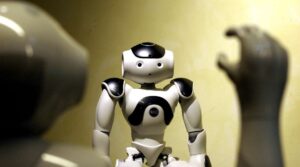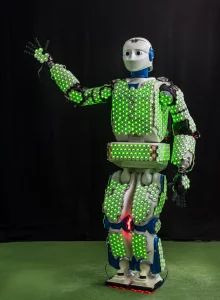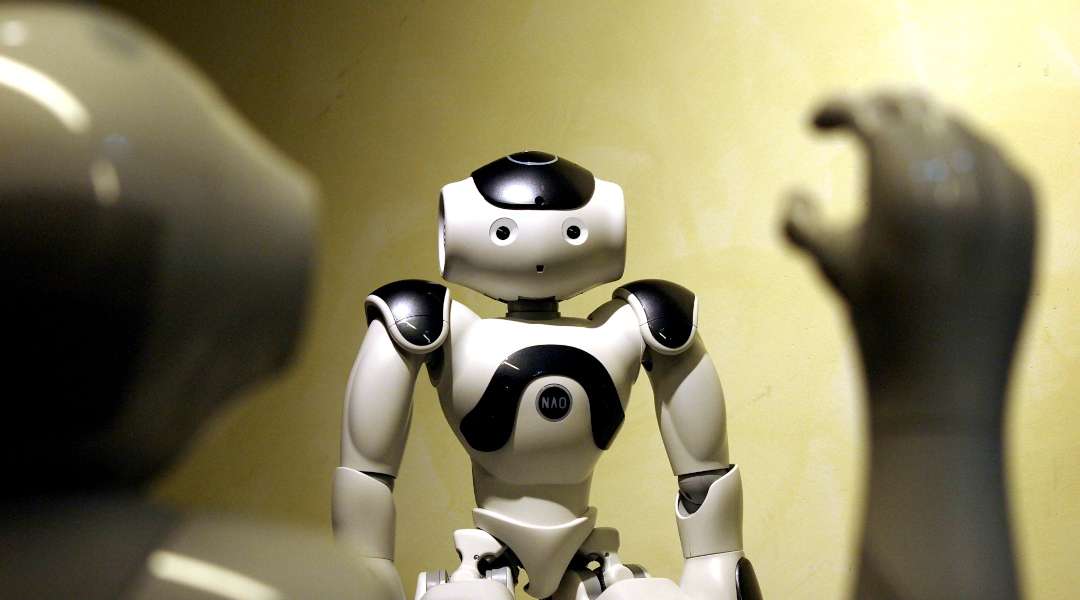
In a groundbreaking leap for robotics, a team at the Technical University of Munich (TUM) has propelled the field forward by integrating sensitive synthetic skin into humanoid robots. This innovative system, inspired by human skin, marries artificial skin with advanced control algorithms, giving birth to the world’s first autonomous humanoid robot adorned with full-body artificial skin.
The Marvel of Artificial Skin
Professor Gordon Cheng and his team’s artificial skin comprises hexagonal cells, each comparable in size to a two-euro coin (approximately one inch in diameter). These cells are not mere structures but house microprocessors and sensors capable of detecting contact, acceleration, proximity, and temperature. The integration of such advanced artificial skin endows robots with a heightened ability to perceive their surroundings with unprecedented detail and sensitivity.
This leap in sensory technology is not confined to a singular breakthrough; it’s a culmination of a decade-long journey. Professor Cheng’s initial skin cell development, approximately ten years ago, paved the way for the realization of artificial skin’s transformative potential when seamlessly integrated into a sophisticated system. The result is a monumental stride in the evolution of robotics, where the intricate dance between artificial and human-like attributes creates a new paradigm for machines.
Enhancing Safety and Interaction
The advent of artificial skin isn’t just a technological marvel; it’s a crucial stride toward enhancing safety in human-robot interactions. By offering robots a sophisticated sensory apparatus, they can navigate their environment more securely, anticipate potential dangers, and actively avoid accidents. This feature becomes particularly pivotal when robots operate in close proximity to humans, ensuring a level of safety and accident prevention that was once deemed futuristic.
The integration of artificial skin is not merely about providing robots with a sensory upgrade; it’s a strategic move to redefine their role in human environments. Robots equipped with such advanced capabilities can play integral roles in areas like nursing care, where close contact with humans is a necessity. As the H-1 robot showcases, it can safely offer a hug—a seemingly trivial act but a testament to the intricacies of calculating movements and contact pressures during close human-robot interaction.
A Decade-Long Innovation Blossoms
Professor Cheng’s journey into the realm of artificial skin began around a decade ago when the initial skin cells were developed. However, the breakthrough potential of this invention manifested fully when these cells were seamlessly integrated into a sophisticated system, marking a monumental stride in the evolution of robotics.
Over the years, the team has been relentless in refining and advancing the technology. The obstacles in developing robot skin were not just technical but computational. The sheer volume of data generated by sensors presented a significant challenge. This led to the application of a NeuroEngineering approach, employing an event-based system that drastically reduces processing efforts. The focus shifted from continuous monitoring to transmitting information only when sensor values change, a strategy mirroring the efficiency of the human nervous system.
Overcoming Computational Challenges
One of the enduring challenges in developing robot skin has been the computational burden posed by the vast amount of data generated by sensors. Human skin, with its approximately 5 million receptors, presents a formidable benchmark. The team addressed this challenge with a NeuroEngineering approach, employing an event-based system that drastically reduces processing efforts by up to 90 percent. This innovation mimics the human nervous system, focusing on transmitting information only when sensor values change.
The NeuroEngineering approach represents a paradigm shift in how artificial skin processes information. Human skin processes sensations in a way that prioritizes new and relevant information while filtering out constant stimuli. The event-based system mimics this efficiency, allowing the robot’s sensory apparatus to focus on critical changes in its environment. This not only ensures a more streamlined and efficient operation but also mirrors the human ability to concentrate on pertinent stimuli in a dynamic environment.
The H-1 Robot: A Marvel of Sensory Autonomy
The pinnacle of this integration is witnessed in the H-1 robot, standing as a testament to the potential of artificial skin. Housing 1260 cells (comprising over 13,000 sensors) across its upper body, arms, legs, and even the soles of its feet, the H-1 robot possesses a heightened “bodily sensation.” Its sensitive feet enable it to respond to uneven surfaces, showcasing a level of adaptability that was once reserved for the realm of science fiction.

The integration of artificial skin into the H-1 robot is not merely a technological feat; it’s a glimpse into the future of robotics. This full-body artificial skin allows the robot to engage with its environment on a profound level. From responding to uneven surfaces with its sensitive feet to balancing on one leg, the H-1 robot showcases a level of autonomy and adaptability that was once deemed the stuff of science fiction. The ability to offer a safe hug demonstrates the intricacies of calculating movements and contact pressures during close human-robot interaction, underscoring the potential applications in areas such as nursing care.
Towards Human-Robot Coexistence
The potential applications of this innovation extend far beyond industrial settings. In fields like nursing care, where robots necessitate close contact with humans, the artificial skin system shines. The H-1 robot, with its special skin, can safely offer a hug—a seemingly trivial act but a testament to the intricacies of calculating movements and contact pressures during close human-robot interaction.
The integration of artificial skin is not merely about providing robots with a sensory upgrade; it’s a strategic move to redefine their role in human environments. Robots equipped with such advanced capabilities can play integral roles in areas like nursing care, where close contact with humans is a necessity. As the H-1 robot showcases, it can safely offer a hug—a seemingly trivial act but a testament to the intricacies of calculating movements and contact pressures during close human-robot interaction.
A Glimpse into the Future
Professor Gordon Cheng’s artificial skin system isn’t merely an accomplishment; it’s a robust and versatile leap into the future of robotics. Designed to remain functional even if some cells cease to operate, this system is poised to become a cornerstone in various robotic applications. As the team works to develop smaller, mass-producible skin cells, the potential for widespread integration of this technology looms on the horizon, promising a future where robots and humans coexist seamlessly and safely.
The journey doesn’t end with the H-1 robot; it’s a stepping stone toward a future where robots, enhanced with artificial skin, become indispensable companions in various facets of our lives. The relentless pursuit of innovation, coupled with a keen understanding of the nuanced interaction between humans and machines, sets the stage for a new era in robotics. As artificial skin continues to evolve, refining its capabilities and expanding its applications, the vision of a harmonious coexistence between humans and robots inches closer to reality.
Related Content:
- Revolutionizing Work: The Impact of AI Assistants on Productivity, Learning, and Job Satisfaction –
- AI Unleashed: Transforming Work Dynamics for a Productive Tomorrow – Micro2media
- Biologically-inspired skin improves robots’ sensory abilities | ScienceDaily
- Unseen Senses: How Marine Life Thrives Without Eyes | Balisharks.com
